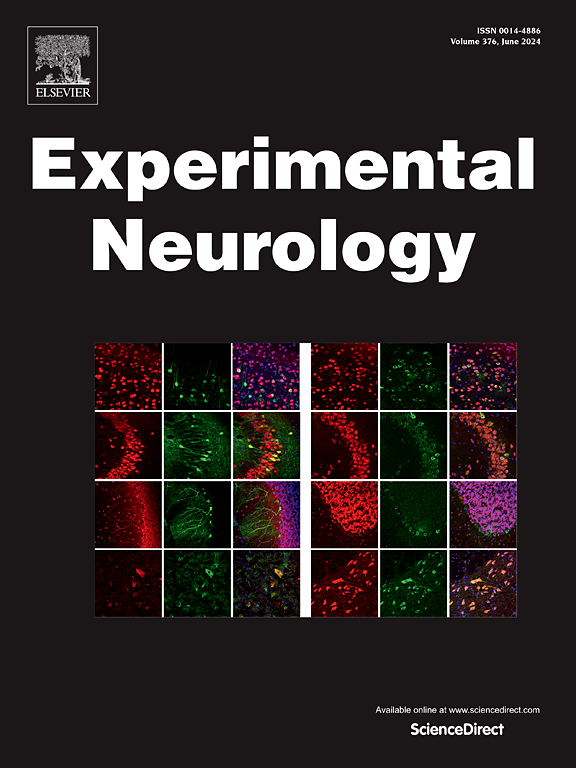Activation of PAR1 contributes to ferroptosis of Schwann cells and inhibits regeneration of myelin sheath after sciatic nerve crush injury in rats via Hippo-YAP/ACSL4 pathway
IF 4.6
2区 医学
Q1 NEUROSCIENCES
引用次数: 0
Abstract
Objective
Peripheral nerve injury (PNI) is characterized by high incidence and sequela rate. Recently, there was increasing evidence that has shown ferroptosis may impede functional recovery. Our objective is to explore the novel mechanism that regulates ferroptosis after PNI.
Methods
LC-MS/MS proteomics was used to explore the possible differential signals, while PCR array was performed to investigate the differential factors. Besides, we also tried to activate or inhibit the key factors and then observe the level of ferroptosis. Regeneration of myelin sheath was finally examined in vivo via transmission electron microscopy.
Results
Proteomics analysis suggested coagulation signal was activated after sciatic nerve crush injury, in which high expression of F2 (encoding thrombin) and F2r (encoding PAR1) were observed. Both thrombin and PAR1-targeted activator TRAP6 can induce ferroptosis in RSC96 cells, which can be rescued by Vorapaxar (PAR1 targeted inhibitor) in vitro. Further PCR array revealed that activation of PAR1 induced ferroptosis in RSC96 cells by increasing expression of YAP and ACSL4. Immunofluorescence of sciatic nerve confirmed that the expression of YAP and ACSL4 were simultaneously reduced after PAR1 inhibition, which may contribute to myelin regeneration after injury in SD rats.
Conclusion
Inhibition of PAR1 can relieve ferroptosis after sciatic nerve crush injury in SD rats through Hippo-YAP/ACSL4 pathway, thereby regulating myelin regeneration after injury. In summary, PAR1/Hippo-YAP/ACSL4 pathway may be a promising therapeutic target for promoting functional recovery post-sciatic crush injury.

PAR1 的激活有助于许旺细胞的铁凋亡,并通过 Hippo-YAP/ACSL4 通路抑制大鼠坐骨神经挤压伤后髓鞘的再生。
目的:周围神经损伤(PNI)的特点是发病率高、后遗症多。最近,越来越多的证据表明,铁蛋白沉积可能会阻碍功能恢复。我们的目的是探索调控 PNI 后铁蛋白沉积的新机制:方法:采用 LC-MS/MS 蛋白组学方法探索可能的差异信号,同时进行 PCR 阵列研究差异因素。此外,我们还尝试激活或抑制关键因子,然后观察铁突变的水平。最后通过透射电子显微镜观察了体内髓鞘的再生情况:蛋白质组学分析表明,坐骨神经挤压伤后凝血信号被激活,其中 F2(编码凝血酶)和 F2r(编码 PAR1)被高表达。凝血酶和 PAR1 靶向激活剂 TRAP6 都能诱导 RSC96 细胞发生铁变态反应,而 Vorapaxar(PAR1 靶向抑制剂)能在体外挽救这种反应。进一步的 PCR 阵列显示,PAR1 的激活可通过增加 YAP 和 ACSL4 的表达来诱导 RSC96 细胞的铁变态反应。坐骨神经免疫荧光证实,PAR1抑制后,YAP和ACSL4的表达同时减少,这可能有助于SD大鼠损伤后的髓鞘再生:结论:抑制PAR1可通过Hippo-YAP/ACSL4通路缓解SD大鼠坐骨神经挤压伤后的铁蛋白沉积,从而调节损伤后的髓鞘再生。总之,PAR1/Hippo-YAP/ACSL4通路可能是促进坐骨神经挤压伤后功能恢复的一个有前景的治疗靶点。
本文章由计算机程序翻译,如有差异,请以英文原文为准。
求助全文
约1分钟内获得全文
求助全文
来源期刊

Experimental Neurology
医学-神经科学
CiteScore
10.10
自引率
3.80%
发文量
258
审稿时长
42 days
期刊介绍:
Experimental Neurology, a Journal of Neuroscience Research, publishes original research in neuroscience with a particular emphasis on novel findings in neural development, regeneration, plasticity and transplantation. The journal has focused on research concerning basic mechanisms underlying neurological disorders.
 求助内容:
求助内容: 应助结果提醒方式:
应助结果提醒方式:


